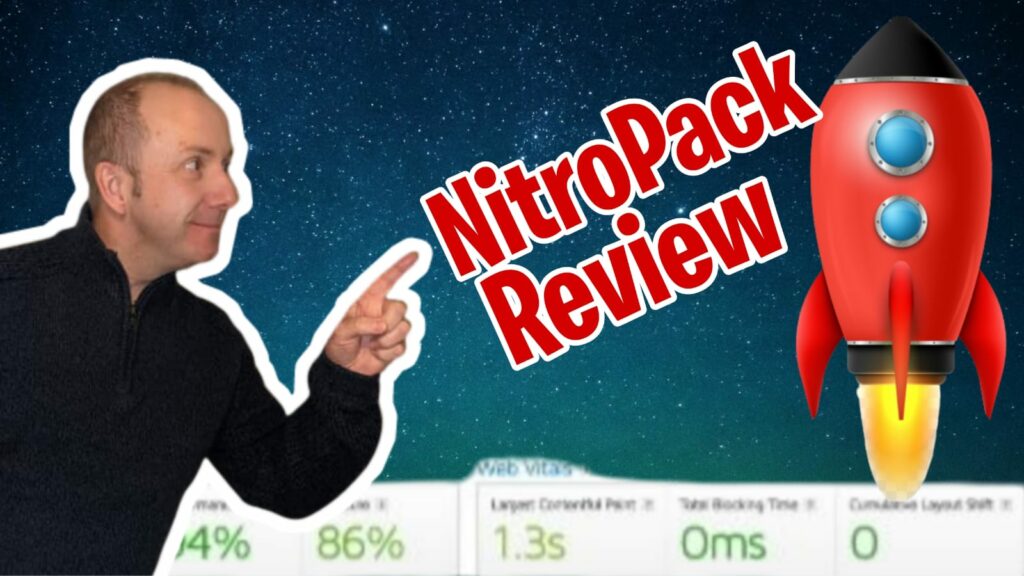In the world of Search Engine Optimization and Google Page Ranking, website owners wanting to increase their visibility and decrease bounce rates, can no longer afford to have their web content load and display at sub-optimal speeds.
There are a number of options, both free and paid, that are available on the market these days.
Today, we will review a relatively new service that is fast gaining a reputation among plug-in website performance solutions – NitroPack (www.nitropack.io). Its mass-market launch was relatively recent, but it has created a lot of buzz.
Several reviewers, on YouTube, articles, and blogs, have conducted live demos showing how NitroPack substantially enhanced the performance of their websites, comparing it to a few other available tools as well. Does it really hold up though? We conducted our own set of reviews to address that question.
What is NitroPack?
NitroPack is a cloud-based “plug-in” service provider that currently serves more than 30,000 clients. The company NitroPack, LLC, was organized in 2018, though the initial version of the service was launched in 2012.
NitroPack reduces load speed times for websites by 50% or more in many cases and is known to boost Page Speed scores dramatically. The company’s website reports the following enhancements on an average basis, as measured by their own tools:
| Speed Scores | 69% |
| Speed Index | 383% |
| FCP | 65% |
| TTI | 51% |
Before we get into more details, including functionality, product features and sample results reported by users, let’s understand why website speed is a critical factor.
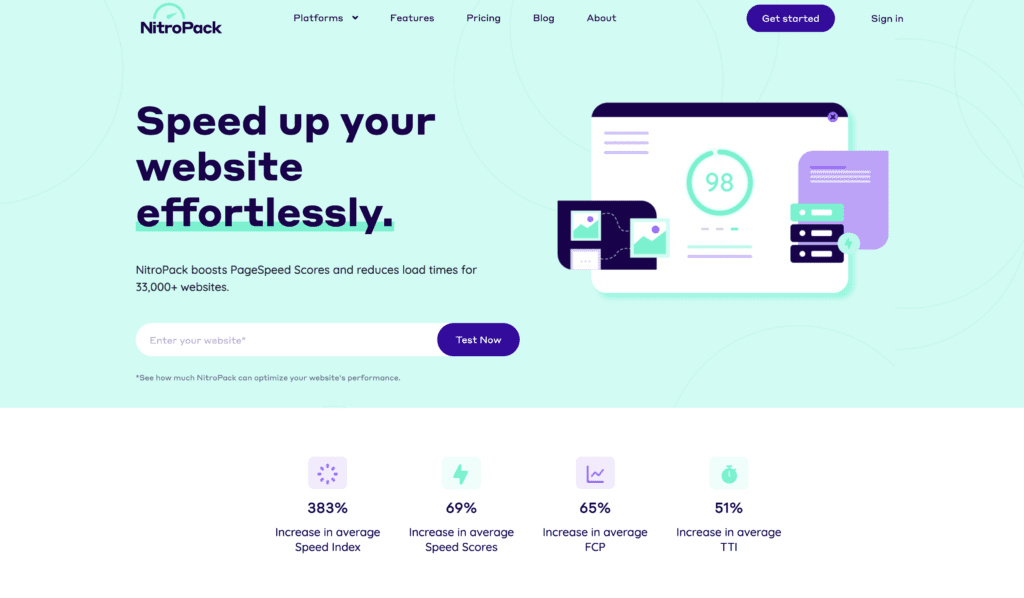
The Importance of Speed as Your Web Page is Loaded
Studies show that webpage speed is absolutely critical in order to attract and retain visitors to the site. Key metrics often reviewed in this regard include:
- Time to First Byte (TTFB) – the time in which the content first loads on the website, is the primary measurement for the responsiveness of a web site
- Largest Contentful Paint (LCP) Loading Time – the time in which the largest content on the screen is loaded, complete, and ready for interaction.
- Render-blocking CSS and JavaScript
- Minifying resources – that is, removing unnecessary characters from HTML, JavaScript, and CSS – as necessary
Key measures of success for a website trying to improve speed and performance include its “bounce rate”, which measures how long a visitor will stay on the site before leaving and the “conversion rate”, the ability to turn a first-time visitor into a regular user.
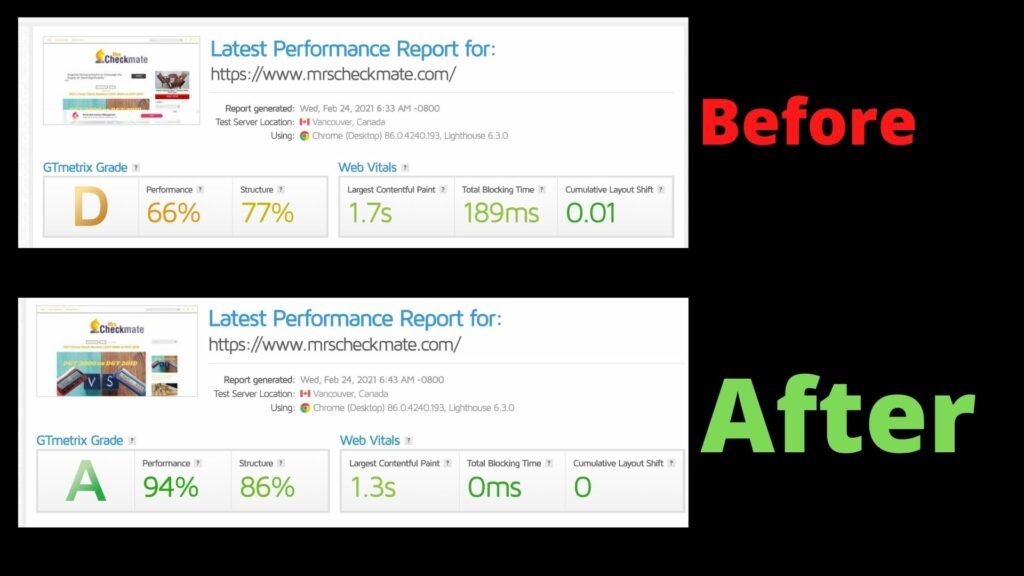
While there could be many reasons for leaving; facing a white page or a page where content takes forever to load; is certainly going to be a major contributing factor – as all of us know from personal experience.
Tools to Measure Website Speed and Performance
On their website, NitroPack offers a user-friendly tool to check where your website speed and performance stands today. There are other online tools, such as GTmetrix, Key CDN Website Speed Test, WebPageTest, and Pingdom Speed Test.
There are multiple testing tools by Google itself (Lighthouse, Speed Scorecard, Test My Site, Impact Calculator, WebPage Speed and PageSpeed Insights (PSI)) that provide performance measurement features.

These tools each provide slightly different functions. Some of them are better to test performance in a lab environment, which may help with debugging but lacks the real-world variability that is introduced when thousands of users, each with their own setups, machines, and internet connectivity issues, try to access your website.
An all-around measure must consider the fact that there is no “representative user”, nor does a single metric cover all aspects of user experience. Speed of page loading (both initial and full content) is a good place to start. PSI ends up being a good indicator for that aspect.
How Does NitropPack Help to Enhance Web Performance?
NitroPack can be described as a ‘3600 tool’ that can do it all in the arena of web speed optimization at an extremely high level.
It covers all the problems and solution areas, such as lazy loading, advanced caching, complete image optimization stack(s), code minification and Content Delivery Network (CDN) optimization.
NitroPack has many other features, some of which are described below.
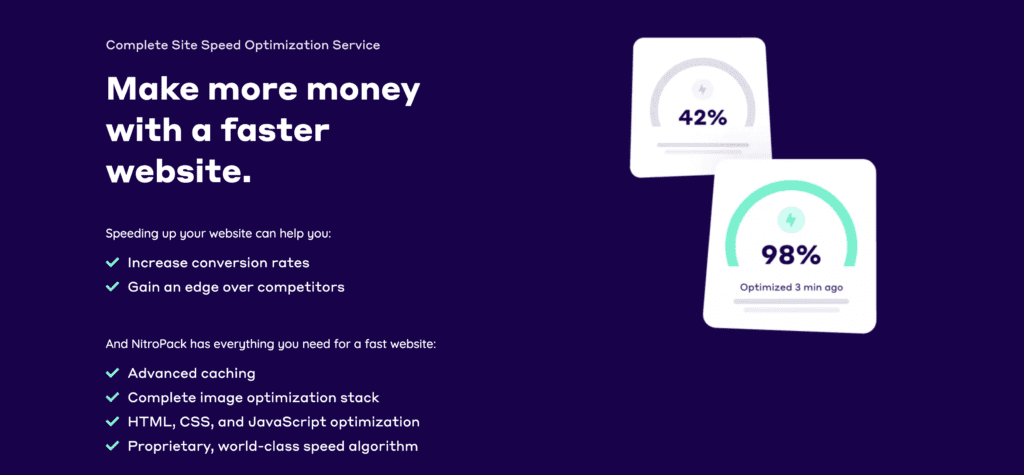
NitroPack Shines in Field Testing Across a Wide Range of Websites and Users
To best approximate what visitors with different machines, bandwidth etc. will consistently encounter on your website, any tool used to calculate efficiency must be one that focuses on Real User Monitoring (RUM). This is where the data shows NitroPack’s advantage.
This trend is demonstrated by the fast-rising trend of NitroPack usage by websites over the past six months, which is mirrored by a steady rise (with a flatter slope) in web traffic.
NitroPack speeds up 33,000+ websites every day!
For a true comparison of its impact, we can examine GTmetrix or PSI scores before and after using a plug-in like NitroPack. To extend the analysis, the effect of NitroPack versus a competing product can also be analyzed using the same tool(s).
Alternatives to NitroPack in the Market
There are a number of other plug-ins that are used for optimizing website performance, such as:
- WP Rocket
- Autoptimize
- Perfmatters
- Jetpack
- Varnish
- W3 Total Cache
- Cloudflare
- WordPress Super Cache
- Litespeed Cache
Not all of the choices above are real substitutes for NitroPack, given that they fulfill different functions. The first four products on the list are considered key competitors to NitroPack..
Up until recently, WP Rocket has been known to be the leading Caching Plug-In product in the market. Launched in 2013, WP Rocket has had a good five-year head start on NitroPack, but the latter seems to be catching up fast despite some growing pains.
NitroPack Works Across Multiple Platforms
NitroPack works across a wide variety of platforms through plug-ins – including WordPress, OpenCart, Magento, and WooCommerce. It’s been designed with flexibility in mind, supporting the needs of both individual users and small companies as well as large eCommerce platforms.
Nitropack is perfect for Drop shipping and E-Commerce stores, Plus local businesses
NitroPack is Cloud-Based, Which Helps Load Speed
Unlike some other plug-ins, NitroPack is cloud-based and not cached on your website. It utilizes Amazon CloudFront – this secure and high-speed CDN allows a connected network of global proxy servers to cache large, dense assets (e.g., multimedia files). As a result, NitroPack does not slow down your website to any degree when it is being run.
Other Attractive Features of Nitropack
There are many reasons why the NitroPack solution has created a stir. Some features include:
- Minifying HTML, CSS, and JavaScript through proprietary optimization tools which delete lines of unused code.
- Next-generation cache management tools that allow efficiencies in terms of cookies and device awareness, allows for flexible cache preloading, and are armed with smart invalidation tools. NitroPack also allows a degree of integration with third-party caches.
- It allows for a highly sophisticated degree of CSS and HTML Optimization.
NitroPack is powered by a proprietary speed algorithm – their secret sauce, so to speak.
NitroPack Is Super Easy to Install, Use and Manage
One of the best features for the average person who is not tech-savvy is how fast and easy NitroPack is to install and then use/manage.
In order to install and run NitroPack, the API must be reconfigured from your computer.
The Download button on the NitroPack website will work for Open Cart plug-ins. Other compatible platforms offer NitroPack as a plug-in on their sites.
For example, if using NitroPack with WordPress, you will find a Download button on the right-hand side towards the upper end of the page: https://wordpress.org/plugins/nitropack/. Clicking it will allow you to connect NitroPack to WordPress to get started.
Next, follow these steps:
- A .zip file will have downloaded – save it on your computer.
- Open the “Plugins” menu on your target website’s dashboard. Click “Add new”. Find the nitropack.zip file and hit “Install Now”.
- Go back to https://nitropack.io/ and create an account and connect your website to the plug-in. After you log in to the NitroPack site, you’ll see a “Connect Your Website” menu on the left. There, you’ll find cells filled out with a Site ID and Site Secret
- Return to your website dashboard. The NitroPack option will show up under “Settings”. Enter your Site ID and Site Secret and click “Connect to NitroPack”.
- If you have any other tools running, such as WP Rocket, you will likely need to deactivate them since NitroPack will not act in parallel to plug-ins with similar functions.
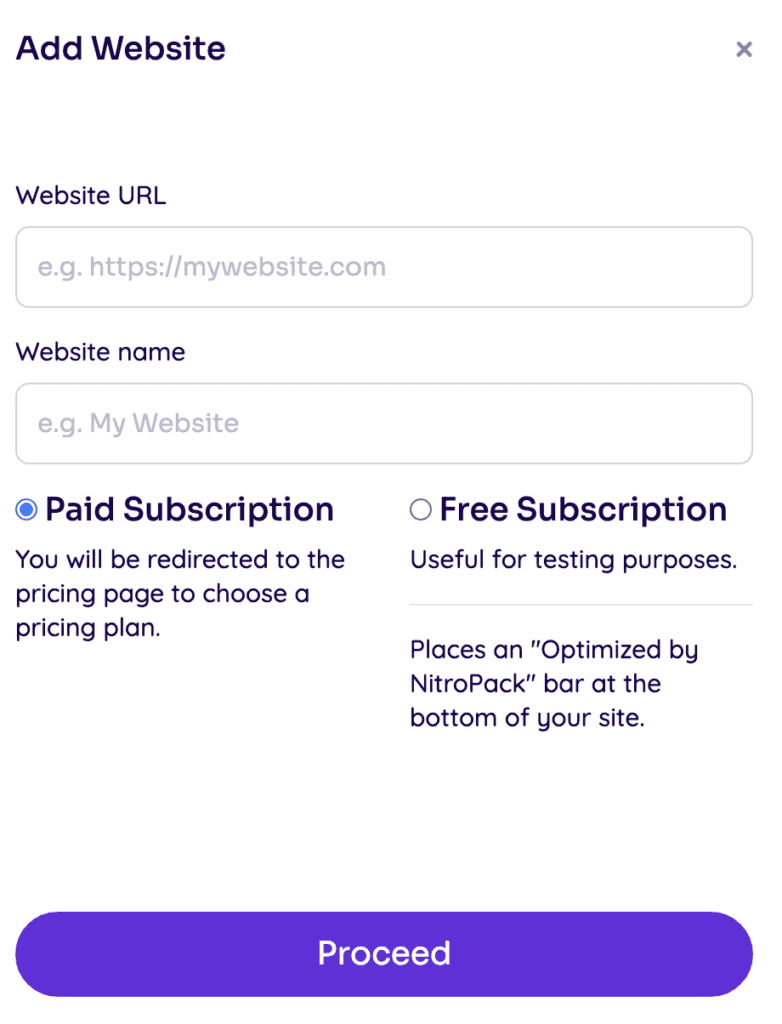
From beginning to end, this process should not consume more than a few minutes.
Some Additional Global Configuration Tips
Initially, you must choose an Optimization Mode setting on NitroPack. The options are Standard, Medium, Strong, Ludicrous and Manual. The normal choice would be between Strong and Ludicrous.
While many experts, confident in their own ability to tweak other settings within their websites, may advocate using the “Ludicrous” mode of optimization, we would recommend beginning with “Strong” – in most cases, it should produce good enough results and will not cause problems with other plug-ins or require adjustments in settings.
You may need to configure the plug-in on your cloud dashboard. Be sure to enable the functionality which allows for the cache to be purged every time the content is updated and published – there is a button right below the Page Optimization box within NitroPack.
This latter step is especially important given how NitroPack operates and its array of cache management tools.
Optimization Results Appear Super-Fast
Once NitroPack is installed, the Dashboard shows you the number of Optimized Pages as the plug-in begins to work. The results also display how many of Mobile, Tablet and Desktop pages have been optimized.
Depending on how many pages you have, it may take anywhere from 10 minutes to 2 hours for NitroPack to show that it has loaded all the pages.
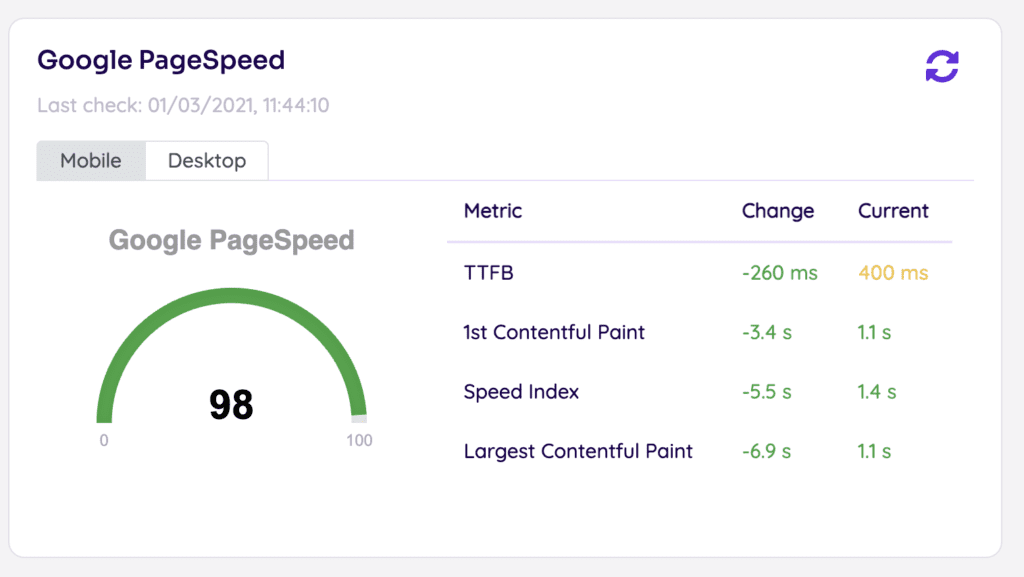
NitroPack automatically creates a backup so your content should be safe. However, it is advisable for you to back up your full site before running any new plug-in which can alter the codes.
Results in terms of GTmetrix or PSI Scores for both Mobile and Desktop applications will go up dramatically within a few minutes of installing and launching NitroPack, far before all the pages are loaded and configured.
You can Try NitroPack for Free, without Submitting Information or Buying a Subscription
A big advantage for a first-time user is the ability to try NitroPack free of charge – unless they already expect a large number of visitors to their website. This allows them to test out the functionality and get comfortable before moving to a paid plan.
As a relatively new player that is scaling up its sales and distribution fast, NitroPack’s pricing has changed over the past few years and may continue to evolve. At the current moment, there are 4 tiers of subscriptions offered:
- Free – Up to 5,000 web page views per month, 1 GB CDN bandwidth added (no credit card or subscription required; the NitroPack badge is added on the website – the badge is removed with a paid service)
- $17.50 per month, billed yearly – Up to 50,000 page views per month, 25 GB CDN bandwidth added
- $42.50 per month, billed yearly – Up to 200,000 page views per month, 100 GB CDN bandwidth added
- $146.67 per month, billed yearly – Up to 1,000,000 page views per month, 500 GB CDN bandwidth added
Discounts are sometimes available, so be sure to contact NitroPack prior to purchase to see if you can utilize one.
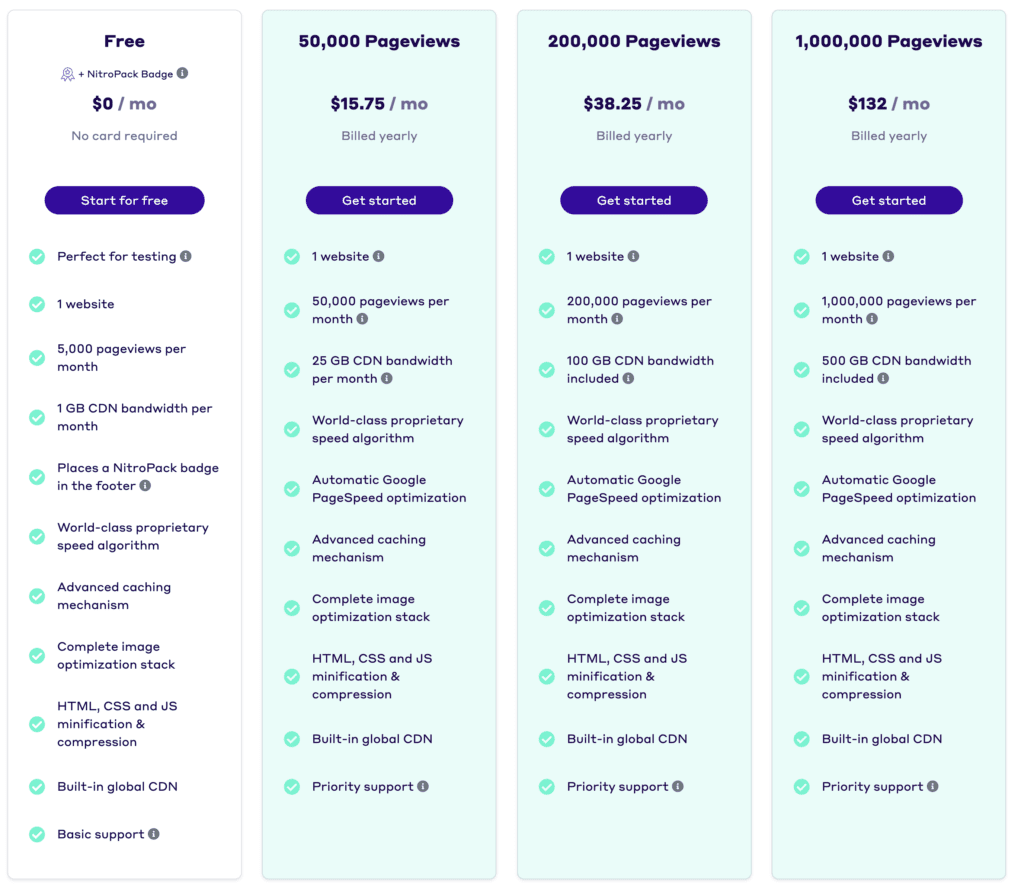
The sign-up, installation and use are simple, as described above. Given that no credit card information is needed for the free sign up, there is no pressure to cancel.
If you do upgrade, cancellation is supposed to be seamless – though the odd complaint has been reported, they are very much the exception rather than the rule.
Side by Side Comparison of NitroPack and WP Rocket
As mentioned before, NitroPack is fast catching up to WP Rocket, which was founded in 2013 and has been considered the #1 Caching Plug-in for a while. Let’s see why!
It is not easy to make a direct comparison in every circumstance, since NitroPack and WP Rocket operate differently. The site BloggingIO compared the two services by adding on Cloudflare CDN to WP Rocket, while NitroPack utilized its in-built CloudFront CDN. Both sites were hosted on the same data server.
Table 1a below captures key differences in performance.
Table 1a: Performance Based Comparison
| Basis | NitroPack | WP Rocket |
|---|---|---|
| Google PageSpeed Score (Mobile) | 99 | 56 |
| Time to Largest Contentful Paint (LCP) | 2.8 Seconds | 7.3 Seconds |
| Total Blocking Time | 210 ms | 270 ms |
| Cumulative Layout Shift | 0.241 | 0.056 |
As Table 1a shows, NitroPack outperforms WP Rocket on every front chosen.
Table 1b: Pricing Comparison
| Basis | NitroPack | WP Rocket |
|---|---|---|
| Trial | Free | Not Available |
| Basic Plan | $17.50/month (50,000 page views) | $49/year for one website |
| Second Level Plan | $42.50/month (500,000 views) | $99/year for three websites |
| Top Tier Plan | $146.67/month (1,000,000 views) | $249/year for unlimited websites |
| Add-ons for CDN and Image Optimization | Not Applicable | RocketCDN @ $7.99/month Imagify @ $4.99/month |
NitroPack is free and has all the add-ons and accessories for those getting less than 5,000 page views per month – you cannot beat that. As Table 1b demonstrates, the story is different if you get into paid subscriptions, WP Rocket turns out to be cheaper.
However, if you need Rocket CDN and Imagify added, then the two products are at par at the starting tier.
Testing Results
In addition to reviewing a number of results posted by NitroPack and third parties, we decided to validate them by conducting tests on a couple of websites ourselves.
We used two methods – Google PSI and GTmetrix – to check scores generated before and after using NitroPack to optimize the sites. Let us first examine how the two tools provide performance scores:
| Google PSI | Provides a composite score by running Lighthouse to collect and analyze lab data about the page. Below 50 indicates Poor, 50-90 indicates a Need for Improvement, 90+ indicates Good trending towards Excellent at the top end. |
| GTmetrix | This comes across as an elaborately constructed score, which examines both your Lighthouse Performance Score (with 70% weightage) and your Structure Score (with 30% weightage). The Performance Score looks at performance, split into Loading Performance (First Contentful Paint, Speed Index and Largest Contentful Paint), Interactivity (Time to Interactive and Total Blocking Time), and Visual Stability. The Structure Score review performs a proprietary audit and assessment combining the Lighthouse Opportunity and Diagnostic Audits. GTmetrix provides both a letter (A through F) and a percentage score. |
Based on the above, here are the results we discovered across multiple test websites on standardized platforms:
On Google PSI
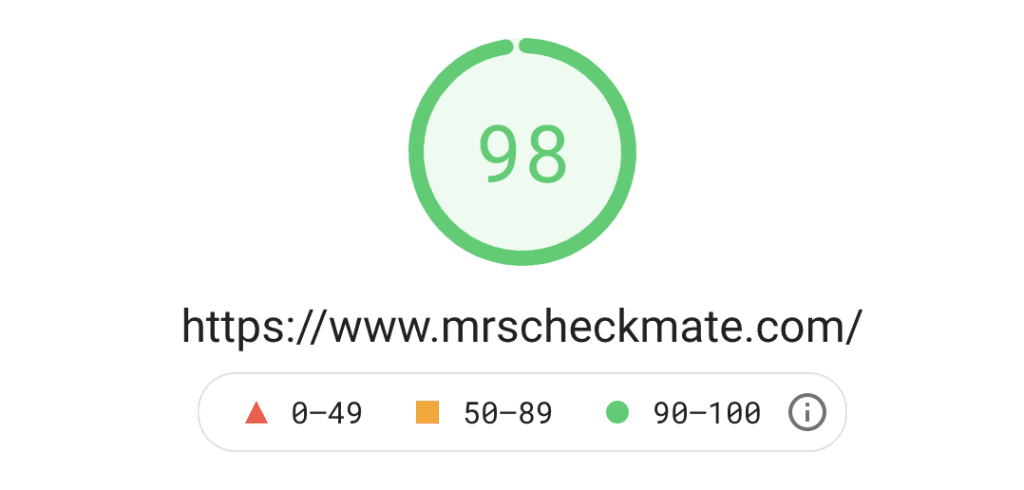
- Initial PSI scores ranged from 4 to 12 for mobile pages, and between 30 to 44 on desktop pages.
- Within 30-45 seconds of installing and running NitroPack – far in advance of the Page Optimization being completed in every test run – the PSI score shot up to above 90. In all cases, we ended up with a score of between 93 and 98 for mobile pages, and 96-99 for desktop pages. These results either remained consistent or edged to the top of those ranges after all the pages were optimized.
On GTmetrix

- Initial GTmetrix scores showed performance levels ranging from B to F on various metrics – the typical range being B-C (86% on the average) on Performance Scores and C-D on YSlow Scores (69% on the average). The average page load speed was 4.8 seconds.
- After running NitroPack, the corresponding scores moved to A – 95% average on Performance Scores, 99% on YSlow Scores, and 1.5 seconds on Page Load Speeds.
The results above clearly demonstrate the efficacy of NitroPack in terms of improving website performance across a range of metrics.
Potential Drawbacks
NitroPack does seem to be experiencing some typical growing pains as the company ramps up its business.
The primary complaints center around inferior Service and Support, especially if the users scale up from (smaller volume) free subscriptions to (larger volume) and/or the plug-in unexpectedly demonstrates incompatibility with other software.
In digging further, there have been issues both with non-availability of support personnel, as well as lack of knowledge on non-routine maintenance and troubleshooting. Again, this is normal with a growing range of customers and expansions in Sales and Service support.
Other issues that elicit complaints include:
- The price for paid subscriptions, since there are lower priced plug-ins like Cloudflare – NitroPack typically responds by pointing out that it has a much better all-around suite of services as described above, and they, therefore, are in a different league.
- Situations where the cached content visible to you (on your own side) may appear fine, but users navigating to the site see garbled coding due to the plug-in’s propensity to rewrite and update code.
- Ad revenues may be compromised in some cases since it minifies ad scripts as part of its normal functionality.
- The badge with free use has been compared to adware – though the company insists that it’s not. Also, the badge gets removed once a paid subscription is started.
- Some ad networks like Ezoic cannot be used if you’re using them with the DNS
Bottom Line: Pros and Cons
Some key findings on the pros and cons of NitroPack are reported in Table 2 below.
Pros
Cons
✅ Provides all-in-one website optimization performance – replacing the need for CDN and plug-ins for caching, code optimization, and image optimization.
✅ Easy installation, use and management.
✅ Reliable and secure in most cases (though there are exceptions as noted under “Cons” and in the previous section).
✅ Focused on Google Page Speed Score – ends up getting you better conversion, more traffic and higher search engine ranking.
✅ Good eCommerce support – plug-ins for WooCommerce, Magento, OpenCart etc. are available.
✅ Will save you money on metered hosting due to its embedded CDN and caching features.
✅ The Pricing Model is enticing for beginners.
✅ Running NitroPack will not cause issues in a data audit, since it is compliant with the General Data Protection Regulations (GDPR).
❌ Could create problems with custom-coded websites when it minifies CSS and JavaScript as part of its normal function.
❌ Updating of new changes can be time-consuming.
❌ Adds a lot of code to the header of your website – this is an essential function that cannot be avoided.
❌ Does not work with other caching plug-ins. But then they are not really needed anymore
❌ May lead to decreased advertisement revenue since it minifies ad script.
❌ Website audit tools will occasionally flag certain things. This bears some watching and may require setting tweaks to iron out all the kinks.
The BloggingX website found that the average webpage speed increased by 57% when using NitropPack even while using CDN, and more than that without CDN use. It rates the optimization tool at 4.7 out of 5 in terms of its Features, Price and Ease of Use; with a slightly lower score of 4.5 on customer support.
The Final Verdict
4.5 / 5 Stars our own rating – Test it yourself for FREE here
Despite some growing pains, the basic architecture and all-in-one features of NitroPack make it an extremely attractive tool for website owners. It has the capability to support large eCommerce platforms, improves webpage performance and speed tremendously, and is easy to install, use and manage.
While some may complain about the price, the wide array of functionality cuts down costs you might be spending on other add-ons or CDN services. Best of all, you can get their free service for web pages with visits of 5,000 and below.
This gives you a chance to familiarize yourself and check out the performance boost (and it’ll be near-instant) at absolutely no risk to you. If your website performs markedly better, the pinch of a paid subscription will be easily covered by the money you make from those improvements.
Bottom line – you cannot afford not to give it a try!

